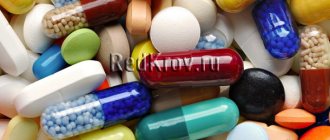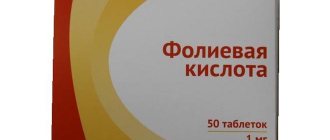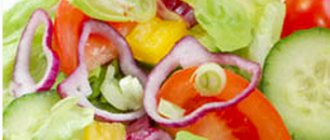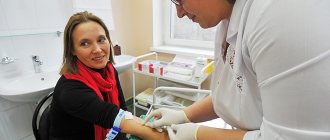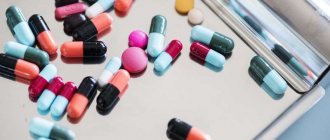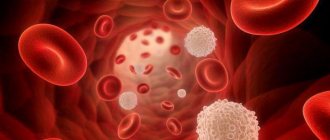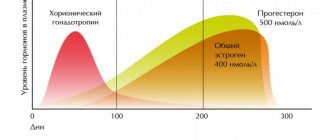Mechanism of pigment formation
Proteins that contain heme, a complex compound, participate in cleavage reactions.
Heme contains substances:
- Hemoglobin is an iron-containing protein
- Myoglobin is an oxygen-binding protein
- Cytochromes are membrane proteins.
Hemoglobin is broken down in cells:
- bone marrow,
- Spleens,
- Lymph nodes,
- Liver.
Bilirubin is a product of red blood cell metabolism and the result of the transformation of complex compounds . This pigment is called non-cohesive (indirect). After breakdown, the substance enters the liver. There it reacts with glucuronic acid.
As a result, the pigment turns into a bound (straight) form. Processed substances enter the bile. After this, they leave the body with feces, turning it brown.
How is bilirubin formed?
Approximately 96% of bilirubin in the blood is in its indirect form .
The rest, as a result of the reaction, can dissolve in water. This is direct bilirubin. It is filtered by the kidneys and excreted in the urine.
Types of bilirubin
When studying the composition of the blood, the content of bilirubin is determined:
- general;
- direct (related, conjugated);
- indirect (unbound, free).
Initially, the spleen produces indirect bilirubin, which is very toxic. It does not dissolve in water and cannot be excreted from the body. Indirect bilirubin can easily penetrate the membrane of any cell and disrupt its normal functioning. Its initial target is the brain, then the entire nervous system comes under attack
That is why it is important that the concentration of this type of bilirubin does not leave the established limits
If the level of free bile pigment is normal, then it enters the liver along with the blood, where it is converted into the direct form of bilirubin.
In this state, the substance is low-toxic, easily dissolves in water, and therefore quickly leaves the body along with feces and urine.
Based on medical research, a hypothesis has been developed that bilirubin is the main cellular antioxidant
And if this is true, then monitoring the level of the substance and not allowing it to go beyond the norm is an important task
Norm
To check the level of bilirubin in the blood, a biochemical test is performed. Material for research is taken from a vein. The test is taken on an empty stomach. The general pigment rate is shown in the table. The data is relevant for people under 60 years of age.
| Pigment form | Indicator in mol/l |
| general | 5,1-17 |
| indirect | 3,4-12 |
| straight | 1,7-5,1 |
Consequences – what are the dangers of increased bilirubin?
A high level of pigment in the blood is the beginning of severe intoxication of the body. All internal organs suffer from the effects of the toxin, but the heart and circulatory system, brain, and kidneys are the first to take the hit. The latter begin to work in enhanced mode, trying to neutralize all substances, but they rarely manage to cope with such a load.
As a result, the development of not only liver failure, but also kidney failure, which, in turn, can cause both the appearance of severe pathologies and the death of the patient. Particularly at risk groups include:
- newborns;
- pregnant women;
- patients with chronic pathologies of any body system, as well as those who have undergone surgery or undergone treatment with potent drugs;
- patients with severe infectious pathologies;
- persons undergoing treatment with hepatotoxic drugs;
- persons suffering from alcoholism;
- patients with liver and gallbladder pathologies;
- persons with immunodeficiencies;
- persons with hereditary bilirubinemia.
Such patients should first of all pay attention to the functioning of the liver and know how to reduce bilirubin in the blood quickly and safely.
Reasons for the increase
The liver of a healthy person regularly removes the substance with bile. Failures in metabolic reactions impede the natural release of bilirubin. The substance accumulates in the body. In this case, the pigment penetrates into the tissue, coloring it yellow.
A high level of bilirubin that has managed to bind in the liver is dangerous for the body. The pigment is toxic.
Total bilirubin increases for several reasons:
- Impaired outflow of bile into the intestine from the biliary tract , which occurs with cholelithiasis, inflammatory processes in the gastrointestinal tract,
- Liver diseases caused by disruptions in metabolic reactions - cirrhosis, hepatitis, hepatosis,
- The release of hemoglobin with the rapid destruction of red blood cells - hemolytic anemia,
- Intense tissue breakdown caused by injury or cancer
- The sequence of reactions of pigment conversion into bile is disrupted,
- Taking certain medications.
Indirect bilirubin is higher than normal in liver failure, Gilbert's syndrome - a disorder of liver synthesis at the cellular level. Gilbert's syndrome occurs when there is a deficiency of a liver enzyme.
Direct bilirubin is elevated in the blood due to pathologies of the biliary tract or is associated with a violation of the outflow of bile.
How to reduce bilirubin in the blood with choleretic and hepatoprotective drugs
To reduce bilirubin, complex therapy is required. Usually two groups of medications are prescribed: choleretic and hepatoprotectors. Only the attending physician should prescribe them after diagnosis.
Regularity is important when taking medications. Some of them are prescribed for several months; the frequency of their use can be reduced over time.
Amino acids
A decrease in bilirubin requires a greater intake of amino acids into the body. These substances are the building blocks for all proteins in the body. When the number of red blood cells decreases, additional sources of amino acids are required.
Effective products whose active ingredients are amino acids:
- Heptral, Heptor, Heparetta (contain ademetionine);
- Hepa-merz (preparation with ornithine);
- Amvix, Ensil, Previn (dietary supplements).
The fact that amino acids play an important role in building protein makes their consumption beneficial. They will not only reduce the amount of bile pigment, but also strengthen the body as a whole.
Essential phospholipids
These drugs belong to the group of hepatoprotective drugs. With an increase in bilirubin associated with diseases of the gallbladder and liver, the membranes of the cells of these organs are damaged. Because of this, their functionality is reduced. Essential phospholipids are used to restore the structure of liver cells.
To reduce bilirubin in the blood, Essentiale forte N is usually prescribed - tablets for oral administration. The main advantages of the drug are that it has virtually no contraindications (except for individual intolerance and age up to 12 years), and can be used for a long time. Also assigned:
- Rezalut about;
- Essliver forte;
- Eslidin;
- Phosphogliv;
- Phosphonziale.
Bile acids
These drugs have a choleretic effect, reducing bilirubinemia levels. Medicines containing ursodeoxycholic and chenodeoxycholic acids are effective:
- Ursoliv;
- Urdoxa;
- Exhol;
- Ursosan;
- Grinterol;
- Henochol;
- Henosan;
- Ursofalk;
- Ursodes.
Preparations of animal origin
To produce medicines of animal origin, the liver of pigs and cattle is used.
Despite their high effectiveness, drugs in this group have a number of contraindications, and therefore are suitable only for the treatment of liver diseases in adults.
Hepatosan is considered an effective preparation of animal origin that can reduce the pigment content. Available in the form of gelatin capsules taken orally. The recommended daily dose is two pieces per day, taken before meals. The duration of treatment is limited - no more than 10 days. Analogues of Hepatosan are Progepar and Sirepar.
Herbal remedies
Extracts of some medicinal plants effectively reduce bilirubin. The advantage of herbal-based medications is their safety; they have practically no contraindications, except for individual intolerance by the body. They normalize the flow of bile into the intestines, due to which they can reduce the absorption of pigment from bile into the blood.
- Effective are preparations based on milk thistle, a unique plant that contains amino acids involved in the breakdown of proteins (Karsil, Legalon, Silimar, Sibektan, Gepabene).
- Pumpkin seeds are also widely used, the oil of which is considered a particularly valuable element. Medicines that lower bilirubin: Tykveol, Peponen.
- Artichoke is another liver healer that can quickly reduce excess toxic substances. Preparations: Artichol, Artichoke extract, Chophytol, Cinacholine.
- Rosehip – found in the preparations Holosas, Hepatofit.
Choleretic
Choleretic drugs, which are divided into three groups, can effectively reduce bilirubin:
- choleretics – Allohol, Hologon, Osalmid;
- cholekinetics – Sorbitol, Flamin;
- Cholespasmolytics - Atropine, Metacin, Fubromegan.
Other medicines
Considering the general harm to the body associated with the effect of increased bilirubin, it is advisable to take vitamin complexes and dietary supplements. If the causes of the phenomenon are associated with infectious damage to the liver or gallbladder, immunostrengthening drugs are also effective.
To reduce excess bilirubin, the following are usually prescribed:
- Multi-tabs Immuno plus;
- Vitrum;
- Centrum;
- Immunal;
- Alphabet.
Treatment
The goal of therapy is to reduce the level of bilirubin in the blood and eliminate associated symptoms. This requires an integrated approach. First of all, the doctor finds out the cause of the increased pigment.
If the deviation from the norm is insignificant and is associated with congenital liver pathologies, drugs that lower bilirubin are used . During treatment, a special diet is followed.
Drugs that lower bilirubin
If the outflow of bile is impaired, choleretic drugs are prescribed. They eliminate pain and fight bile stagnation.
There are several groups of such drugs that can normalize the condition:
- Choleretics. They increase bile production. The drugs are prepared from herbal infusions or obtained synthetically. Natural medicines for increased bilirubin include: sandy immortelle, pine, St. John's wort, etc. Popular medicines: Allohol, Lyobil, Cholenzym.
- Cholekenetics. To eliminate congestion, Mannitol, Flamin, Holosas are prescribed.
Medicines to reduce bilirubin are prescribed taking into account chronic diseases and possible contraindications. Self-medication is unacceptable.
If the disease is hereditary, treatment is aimed at eliminating the symptoms.
Reduce pigment with medications:
- Choleretic agents,
- Sorbents – Activated carbon, Smecta, Polysorb,
- Herbal infusions.
Sometimes increased bilirubin is associated with immune disorders and inflammatory processes in the liver.
In these cases, treatment is carried out with drugs:
- Hepatoprotectors are agents that have a positive effect on liver function, protect organ cells from damage,
- Antibacterial drugs.
- Antiviral drugs.
- Enzymes are complexes that accelerate chemical reactions in the body. These include: Pancreatin, Mezim, Festal.
To reduce bilirubin levels after intoxication, it is necessary to improve metabolism and remove harmful substances from the body. To do this, take antioxidants and sorbents. In severe cases, intravenous injections of detoxification drugs and glucose are prescribed . As a result, there is a decrease in the dangerous pigment in the blood.
If the increase in bilirubin is caused by Gilbert's syndrome, treatment with Zikrorin and Phenobarbital is prescribed. Enzymes will help relieve the symptoms of the disease.
At home
Bilirubin is reduced with decoctions of medicinal plants. For example, milk thistle infusion.
Plant-based products are considered effective:
- Karsil,
- Essentiale forte,
- Rezalut Pro.
How to quickly normalize bilirubin levels?
There is no clear answer. The doctor prescribes treatment depending on the cause of the increase in pigment. Each case is individual. Treatment is complex and requires adherence to a strict diet. If you follow all the doctor’s instructions and exclude prohibited foods from your diet, your bilirubin level will return to normal faster.
Diet
During treatment, avoid foods that burden the liver.
These include:
- Coffee,
- Alcohol,
- Mushrooms,
- Radish,
- Fast food,
- Fried foods,
- Smoked meats,
- Spicy seasonings,
- Pickles,
- Preservatives,
- Sour fruits, berries.
Video test for bilirubin
What foods reduce bilirubin in the blood?
The basis of the diet with a high level of pigment is natural food without dyes, preservatives and flavor enhancers.
It is recommended to focus on:
- Egg white,
- Dairy products,
- Sweet fruits,
- Lean meat,
- Vegetables,
- Cereals,
- Fruit drinks,
- Mineral water,
- Herbal teas.
Consuming foods and drinks that reduce bilirubin will speed up your recovery.
Folk remedies
Before treatment with alternative medicine, consult a doctor, since the reason for the deviation is different for everyone. There is no single recipe that fits every case of violation . Treatment with folk remedies is practiced along with drug therapy for a noticeable effect.
What lowers bilirubin levels:
- A decoction of birch leaves. The leaves are dried and crushed. For the decoction, take 1 tbsp. funds for a glass of boiling water. Before use, the decoction is infused for 30 minutes, taken once a day before bedtime. Birch leaves remove toxins from the liver and improve its functioning.
- Herb tea. To prepare the drink, take St. John's wort, motherwort and chamomile. Dry plants are crushed and poured with boiling water at the rate of 1 tbsp. per glass of water. The drink is left to brew for 30 minutes. Take 20-30 minutes before meals.
- Beetroot juice. It is squeezed out before use. Beetroot components accelerate the flow of bile and help cope with problems of congestion. Drink juice before meals, 1/3 of a glass.
- Decoction of corn silk. A pinch of herbal remedy is brewed with a glass of boiling water. After half an hour, the broth is ready for use. Drink the infusion 2 times a day, 1/2 cup.
- Motherwort infusion. Brew 1 tbsp in a glass of boiling water. herbs. Leave for 30 minutes. Take 1 tbsp decoction. on an empty stomach.
Removing bilirubin with a detox diet
A diet for elevated bilirubin is not an independent method of therapy, but it promotes rapid recovery and enhances the effect of medications. It is easier to lower the required indicators with its help. The basic rule of nutrition is to strictly avoid the following foods:
- salt - dishes are prepared without adding it;
- salt-containing spices;
- some greens - sorrel, spinach, green onions;
- flour, especially fresh baked goods;
- canned food, pickles;
- smoked meats, sausages;
- sugar, sweets;
- alcohol.
The rest of the products can be eaten. It is difficult for overweight people to reduce bilirubin, so when choosing a diet for them, the doctor can set the permissible amount of calories. Fiber-containing foods can be especially good at reducing pigment levels.
Increased bilirubin during pregnancy
The concentration of yellow pigment increases during pregnancy.
This is due to the rapid growth of the fetus. Every week the pressure on the internal organs increases. Including the liver.
As a result of compression, the outflow of bile becomes difficult . Stagnation occurs. This is why bilirubin accumulates.
During pregnancy, most medications are prohibited. To reduce bilirubin levels, you need to follow a diet and drink herbal teas. Infusions are also taken with caution, after consultation with a gynecologist.
Menu (Power Mode)
The diet forces you to give up your favorite foods, but it must be followed for several months. If you create a diet so that it includes alternating protein dishes, different cereals and vegetables, the nutrition will not be monotonous. It will also help to use different methods of preparing them, because Table No. 5 provides for this. The menu can be modified according to your capabilities and taste preferences. Keep your salt intake to a minimum, try to include fruits, berries or vegetables in every meal, and fermented milk drinks at night.
| Breakfast |
|
| Lunch |
|
| Dinner |
|
| Afternoon snack |
|
| Dinner |
|
| For the night |
|
| Breakfast |
|
| Lunch |
|
| Dinner |
|
| Afternoon snack |
|
| Dinner |
|
| For the night |
|
| Breakfast |
|
| Lunch |
|
| Dinner |
|
| Afternoon snack |
|
| Dinner |
|
| For the night |
|
Increased bilirubin levels in newborns
In infants, excess levels of the substance in the blood are common. The condition is called “newborn jaundice.” This condition is not life-threatening and is considered a physiological phenomenon. The reason is the reaction of destruction of hemoglobin during labor.
How can bilirubin be reduced in newborns?
When the deviation from the norm is insignificant, no measures are taken. Bilirubin quickly returns to normal without any help. If this does not happen, phototherapy is used - light treatment.
Phototherapy is a physiotherapeutic procedure that uses ultraviolet rays. The child lies under the lamps several times a day. In this case, bilirubin is converted into an isomer and removed from the body physiologically.
Breastfeeding plays an important role in reducing bilirubin. The more often the baby is put to the breast, the faster the yellow pigment returns to normal. The volume of fluid in newborns with jaundice is increased by 10-20%.
Special case: neonatal jaundice
It should be noted that jaundice is quite common in newborn babies and, as a rule, goes away on its own by the first month of life. It does not pose a danger to the baby, as it is determined by the individual characteristics of the newborn organism. A child with this diagnosis must be under the supervision of a specialist to avoid transforming the disease into a severe form.
Pathological jaundice requires therapy, as it can cause serious damage to the health of not only a newborn child, but also an adult.
Consequences
The risk of complications increases if you ignore the symptoms of high bilirubin or refuse treatment.
Toxic substances released as a result of excess bilirubin negatively affect vital organs in both children and adults:
- Brain. Under the influence of toxins, its functions are reduced.
- Liver. The organ gradually deteriorates if left untreated.
- Kidney activity decreases. As a result, the risk of infections and inflammatory processes increases.
Authorized Products
- To prepare dishes, use lean beef, veal, rabbit, and chicken. It is recommended to boil them and then bake them. It is allowed to eat in pieces or in the form of cutlets, dumplings, meatballs, casseroles.
- Cereal and vegetable soups based on vegetable broths, borscht and cabbage soup. However, vegetables should not be fried to season soups and borscht.
- You can eat salt-free bread; if you can’t find one, you can bake it yourself or use salt-free bread. You can eat homemade low-fat, unsalted cookies and biscuits without soda.
- Low-fat river (pike, crucian carp, pike perch, carp) and sea (cod, blue whiting, navaga, pollock, hake) fish. The fish is boiled or baked with vegetables and rice.
- Eggs are used to make omelettes or boil them soft-boiled.
- Low-fat fermented milk products (kefir, natural yogurt, acidophilus, yogurt), low-fat cottage cheese. Milk is most often poorly tolerated by patients, so it is used only in dishes. Sour cream is also limited in the dishes. Butter (vegetable) oil is for seasoning dishes and is not allowed to be consumed thermally processed.
- Any cereals are allowed according to preference and tolerance. Millet often causes heartburn, and pearl barley causes heaviness in the stomach. Cereals are used in the form of porridges, in soups, casseroles with meat and vegetables, and cottage cheese.
- Any vegetables (except for sorrel, radishes, spinach, all types of radishes, mushrooms, garlic and fresh onions).
- They should be consumed baked or boiled. Quenching is not recommended due to the formation of concentrated extractive substances.
- The diet includes a large selection of vegetable dishes: salads, salads with meat or fish, caviar, mashed potatoes, stews, casseroles. You can add dill or parsley to all dishes.
- Fruits and berries are chosen from sweet varieties and when ripe. Consumption in fresh and processed forms (compotes, fruit drinks, fruit sauces, jelly) is allowed.
- Still water, marmalade, caramel, vegetable juices, honey, jam, weak tea, rosehip infusion are allowed.
Table of permitted products
| Proteins, g | Fats, g | Carbohydrates, g | Calories, kcal | |
Vegetables and greens | ||||
| eggplant | 1,2 | 0,1 | 4,5 | 24 |
| zucchini | 0,6 | 0,3 | 4,6 | 24 |
| cabbage | 1,8 | 0,1 | 4,7 | 27 |
| broccoli | 3,0 | 0,4 | 5,2 | 28 |
| carrot | 1,3 | 0,1 | 6,9 | 32 |
| cucumbers | 0,8 | 0,1 | 2,8 | 15 |
| salad pepper | 1,3 | 0,0 | 5,3 | 27 |
| parsley | 3,7 | 0,4 | 7,6 | 47 |
| iceberg lettuce | 0,9 | 0,1 | 1,8 | 14 |
| tomatoes | 0,6 | 0,2 | 4,2 | 20 |
| pumpkin | 1,3 | 0,3 | 7,7 | 28 |
| dill | 2,5 | 0,5 | 6,3 | 38 |
Fruits | ||||
| bananas | 1,5 | 0,2 | 21,8 | 95 |
| apples | 0,4 | 0,4 | 9,8 | 47 |
Nuts and dried fruits | ||||
| raisin | 2,9 | 0,6 | 66,0 | 264 |
| dried figs | 3,1 | 0,8 | 57,9 | 257 |
| dried apricots | 5,2 | 0,3 | 51,0 | 215 |
| dried apricots | 5,0 | 0,4 | 50,6 | 213 |
| prunes | 2,3 | 0,7 | 57,5 | 231 |
Cereals and porridges | ||||
| buckwheat (kernel) | 12,6 | 3,3 | 62,1 | 313 |
| oat groats | 12,3 | 6,1 | 59,5 | 342 |
| pearl barley | 9,3 | 1,1 | 73,7 | 320 |
| rice | 6,7 | 0,7 | 78,9 | 344 |
Flour and pasta | ||||
| pasta | 10,4 | 1,1 | 69,7 | 337 |
| noodles | 12,0 | 3,7 | 60,1 | 322 |
| buckwheat noodles | 14,7 | 0,9 | 70,5 | 348 |
Bakery products | ||||
| bran bread | 7,5 | 1,3 | 45,2 | 227 |
| whole grain bread | 10,1 | 2,3 | 57,1 | 295 |
Confectionery | ||||
| jam | 0,3 | 0,2 | 63,0 | 263 |
| jelly | 2,7 | 0,0 | 17,9 | 79 |
| marshmallows | 0,8 | 0,0 | 78,5 | 304 |
| milk candies | 2,7 | 4,3 | 82,3 | 364 |
| fondant candies | 2,2 | 4,6 | 83,6 | 369 |
| fruit and berry marmalade | 0,4 | 0,0 | 76,6 | 293 |
| paste | 0,5 | 0,0 | 80,8 | 310 |
| Maria cookies | 8,7 | 8,8 | 70,9 | 400 |
Raw materials and seasonings | ||||
| honey | 0,8 | 0,0 | 81,5 | 329 |
| sugar | 0,0 | 0,0 | 99,7 | 398 |
Dairy | ||||
| kefir 1.5% | 3,3 | 1,5 | 3,6 | 41 |
| Ryazhenka | 2,8 | 4,0 | 4,2 | 67 |
Cheeses and cottage cheese | ||||
| cottage cheese 1% | 16,3 | 1,0 | 1,3 | 79 |
Meat products | ||||
| beef | 18,9 | 19,4 | 0,0 | 187 |
| rabbit | 21,0 | 8,0 | 0,0 | 156 |
Bird | ||||
| boiled chicken breast | 29,8 | 1,8 | 0,5 | 137 |
| boiled chicken drumstick | 27,0 | 5,6 | 0,0 | 158 |
| boiled turkey fillet | 25,0 | 1,0 | — | 130 |
Eggs | ||||
| soft-boiled chicken eggs | 12,8 | 11,6 | 0,8 | 159 |
Fish and seafood | ||||
| flounder | 16,5 | 1,8 | 0,0 | 83 |
| pollock | 15,9 | 0,9 | 0,0 | 72 |
| cod | 17,7 | 0,7 | — | 78 |
| hake | 16,6 | 2,2 | 0,0 | 86 |
Oils and fats | ||||
| butter | 0,5 | 82,5 | 0,8 | 748 |
| olive oil | 0,0 | 99,8 | 0,0 | 898 |
| sunflower oil | 0,0 | 99,9 | 0,0 | 899 |
Non-alcoholic drinks | ||||
| water | 0,0 | 0,0 | 0,0 | — |
| mineral water | 0,0 | 0,0 | 0,0 | — |
| green tea | 0,0 | 0,0 | 0,0 | — |
Juices and compotes | ||||
| apricot juice | 0,9 | 0,1 | 9,0 | 38 |
| carrot juice | 1,1 | 0,1 | 6,4 | 28 |
| peach juice | 0,9 | 0,1 | 9,5 | 40 |
| plum juice | 0,8 | 0,0 | 9,6 | 39 |
| tomato juice | 1,1 | 0,2 | 3,8 | 21 |
| pumpkin juice | 0,0 | 0,0 | 9,0 | 38 |
| rose hip juice | 0,1 | 0,0 | 17,6 | 70 |
| * data is per 100 g of product | ||||
Basic principles of diet
The purpose of a special diet for high bilirubin is to relieve the liver as much as possible, stimulate the exchange of pigments and fats, as well as the timely outflow of bile from the body. The basic components of the diet are fully consistent with Diet No. 5, which is invariably prescribed to those suffering from liver and gallbladder diseases. Its description is contained in any medical reference book on dietetics.
The undoubted advantage of this diet is the wide variety of acceptable foods and the generally universal nature of the diet, thanks to which it can be considered a normal healthy diet.
With an average calculation, the desired distribution of chemical components should be as follows:
- 100 g proteins
- 400 g carbohydrates
- 80-90 g fat
Particular attention should be paid to fluid in the diet, which should be up to 2.5 liters per day. This is table water without gases and dyes. Very useful are compotes from sweet varieties of fruits and berries, decoctions and infusions of herbs, weak tea, or green tea.
The main restrictions are imposed on salt and salt-containing products - they are included in the section of absolutely prohibited foods. The list continues with alcohol, as well as any carbonated drinks. All soda- and yeast-containing products, as well as those rich in purines, abound in refractory fats and heavy fiber, are subject to taboo.
The main useful content of the therapeutic diet is everything that actively helps reduce the level of pigment in the blood and fat metabolism, prevents the liver from degradation, cleanses blood vessels, reduces the risk of formations involving cholesterol, and also removes bile from the body.
That’s why it’s so important to include foods rich in fiber, pectins and lipotropic compounds in your daily list. This means almost all vegetables (with the exception of pungent, bitter ones and those containing oxalic acid), fruits (with the exception of sour citrus fruits) and sweet berries. The basis of the diet is carbohydrate, but the presence of a sufficient amount of proteins and polyunsaturated fats makes it acceptable for adherence over a long period of time.
Another important feature of the diet is split meals in small portions . This will support the regular flow of bile from the body, and will also prevent liver overload, which occurs when overeating. Allowed types of heat treatment: boiling, steaming and baking.
Stewing is not recommended , as this results in a high concentration of extractive elements harmful to the liver. The temperature of prepared dishes should always be warm, and in no case cold, so that the bile ducts are not blocked.
The average daily calorie intake is about 2500 kcal. The final nice touch in favor of the diet is its relative cheapness. So, if you adhere to the approximate menu given in our article, weekly expenses will not exceed 1,500 rubles per person.
Other proven methods
Traditional medicine knows ways to get rid of jaundice. The main thing is that before choosing any of them, you need to consult a doctor, undergo tests to identify the cause of the increased pigment content, as well as concomitant diet therapy.
- Beetroot juice. This remedy can enrich the blood with hemoglobin and cleanse the body of toxins, and promotes the rapid removal of bile from the body. You can prepare the juice in the evening. To do this, peeled and briefly soaked beets should be rubbed on a plastic grater and sprinkled with granulated sugar (a glass - two tablespoons). In the morning, squeeze out the juice that has given out and take a third of a glass on an empty stomach.
- Corn silk. An excellent diuretic and choleretic anti-inflammatory agent. Two spoons of corn silk are poured with boiling water and infused to take before bed (dose - half a glass).
- Infusions of choleretic herbs. St. John's wort, chamomile, and mint have the necessary healing effect. Special pharmacy fees should be used. The recommended method of preparing the decoction is a water bath. A lighter option is targeted herbal tea, which also needs to be purchased at the pharmacy. You need to drink half a glass of infusion twice a day. Results will appear in two to three weeks.
- Birch leaf. The dry mixture is poured with boiling water and brought to readiness in a water bath. Take half a glass before bed.
Prevention or how to avoid increasing pigment levels
Reducing bilirubin at home is not difficult, but it is better to take all measures to maintain it within a healthy range, and the recommendations in this case are simple.
Compliance with healthy eating rules. For prevention purposes, it is necessary to add non-acidic vegetables, fruits, berries and herbs to the menu. Following a strict diet is not required, but you need to eat often, in small portions, do not skip breakfast and do not go to bed with a full stomach.
Another important factor is bad habits. Abuse of even weak alcoholic drinks (beer, liquor, wine) has a detrimental effect on liver health, and addiction to strong alcohol and low-alcohol drinks containing dyes and artificial additives can lead to severe liver damage.
It is important to undergo a full medical examination annually and take the necessary tests - this will allow you to promptly identify any diseases and take measures to combat them in the early stages, when complex and lengthy treatment is not required.
First, let's figure out what bilirubin is? What is hidden behind this beautiful word? But there is nothing beautiful behind it. Bilirubin is a pigment that is produced during the breakdown of hemoglobin. After bilirubin appears in our body, the liver takes over, starting the process of its disinfection. If the liver does not cope with its work, the concentration of bilirubin in the blood and bile increases, which is very bad for our health, since bilirubin is very toxic.
